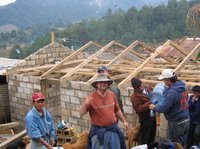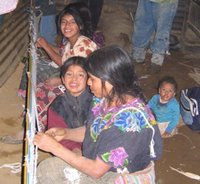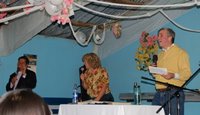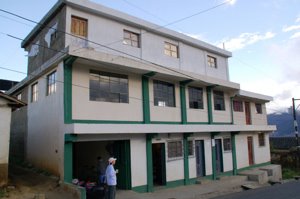Two years later many Americans, including this one, are questioning their earlier support of the invasion of Iraq. For me the struggle has not been one of second guessing the "evidence". It's easy to do so in light of the many errors, even perhaps misrepresentations, regarding what the situation in Iraq was. But as I read Michael Novak's recent letter on the "First Things" blog I'm reminded of how little evidence was really required to support our efforts based on traditional "just war" theories. (It's worth reading Novak's original Vatican lecture referenced in the letter to learn more about the "just war" theory).
No, I'm still convinced that the threat of biological/chemical attack aided and abetted by Saddam was quite real. Having worked for a biotech company and learned in some detail the mechanisms of such an attack, I am regrettably still convinced this is a real possibility. It just won't be supported by the same players.
And this gets closer to the heart of my questions surrounding the invasion: Does even a "just war" ever accomplish anything in the long run? Surely it is not sufficient, but is it necessary?
I've never been a pacifist, and I'm not one now. At least not yet. But if "just war" is necessary but not sufficent to bring about peach, we surely lack the remaining ingredients in the world today. Of course I don't expect to find the "solution." To my friends who would point out that answer is surely Jesus Christ, I would respond:
Yes. You are absolutely correct, and we are to abide in Him so he may abide in us which makes us a key part of the answer. Yet this brings me right back to where I started: How am I to play my part in the answer? Did Jesus fight a "just war"? Did he not teach that our battle was not against the Roman Empire which, like Saddam Hussein, held together its infamour Pax Romana through brutality and oppression? Isn't the battle against the powers of darkness who fuel the Cult of Personalities so prominent among the political powers then as they are today?
For now my questioning is leading me to read Miroslav Volf's Exclusion and Embrace: A Theological Exploration of Identity, Otherness, and Reconciliation. I'm only 1/3 of the way into it but I can see why Brian McLaren gave it such high marks. Volf, a Croatian theologian now teaching at Fuller Seminary, has experienced first hand the horrors exclusion in the name of piety (such as the Serbian Orthodox ethnic cleansing in the Balkans).
One the things I'd like to do this coming year is read more studiously, or at least to capture notes from my reading. I love to read, and I read a lot, but sometimes I wonder if I'm not reading too much. Perhaps by taking the time to capture things as I go, I'll moderate the pace and retain more of what I do read. We'll see.
Tuesday, December 27, 2005
Sunday, December 25, 2005
Guatemala Part 2
My primary activity was helping to build a block house for a widow, Thomasa, and her family (six children and two parents). You can see the home they have been living in the background on the left and the nearly completed replacement on the right.


Here is a group shot of the building team on the left and Thomasa and three of her children inside their old home weaving, their primary means of income, on the right.


One of the most amazing things was to see how hard the family worked. The girls, who think were about 10 and 12 carried wheel-barrow load after load of sand. Here is Thomasa's mother carrying one of many loads of blocks to the job site.



Here is a group shot of the building team on the left and Thomasa and three of her children inside their old home weaving, their primary means of income, on the right.


One of the most amazing things was to see how hard the family worked. The girls, who think were about 10 and 12 carried wheel-barrow load after load of sand. Here is Thomasa's mother carrying one of many loads of blocks to the job site.

Tuesday, December 20, 2005
Highlights from Guatemala
Jesse reminded me that I haven't posted anything on my trip last month to Guatemala...so here it goes part one of multi-part post (this is also a good chance to test out posting pictures).

I went as part of a 10 person team. Six of us were from the Ann Arbor Vineyard and four from First Presbyterian of Brighton. Our mission was to support the work of Teri Litrell who is a full-time missionary in Vasquez, Guatemala (and the aunt of John Starkweather, a member of the A2 Vineyard).
Teri has established a clinic in Vasquez where she trains local Mayan women to be nurses and serves as a general advocate for the people. Here she is with some of her students (and Esther Brunson from Ann Arbor).

 I was honored to be able to deliver the Sunday sermon the day after we arrived. It was a humbling experience. The people were very warm and friendly, but by the time my words were translated into Spanish, by Teri, and then Quiche (prounced kee-chay), by Pastor Obispo, it was very difficult to get into any kind of rhythm. It also tripled the time, so my nice 20 minute sermon dragged on past an hour. On top of this, the kids ran around freely and the adults, who primarily spoke Quiche, chatted during the english and spanish parts. This all took some getting used to, but all in all it was a very valuable experience.
I was honored to be able to deliver the Sunday sermon the day after we arrived. It was a humbling experience. The people were very warm and friendly, but by the time my words were translated into Spanish, by Teri, and then Quiche (prounced kee-chay), by Pastor Obispo, it was very difficult to get into any kind of rhythm. It also tripled the time, so my nice 20 minute sermon dragged on past an hour. On top of this, the kids ran around freely and the adults, who primarily spoke Quiche, chatted during the english and spanish parts. This all took some getting used to, but all in all it was a very valuable experience.

I went as part of a 10 person team. Six of us were from the Ann Arbor Vineyard and four from First Presbyterian of Brighton. Our mission was to support the work of Teri Litrell who is a full-time missionary in Vasquez, Guatemala (and the aunt of John Starkweather, a member of the A2 Vineyard).
Teri has established a clinic in Vasquez where she trains local Mayan women to be nurses and serves as a general advocate for the people. Here she is with some of her students (and Esther Brunson from Ann Arbor).

We stayed with the family of Sefarino and Maria, who took Teri in some 12 years ago after she first came to Vasquez.  Through the years, the support Teri has received has enabled her to build "Sefi" and Maria a nice building complex with room for the loom, a clinic, a classroom/chapel and several guest rooms as well as space for the extended family (pictured below).
Through the years, the support Teri has received has enabled her to build "Sefi" and Maria a nice building complex with room for the loom, a clinic, a classroom/chapel and several guest rooms as well as space for the extended family (pictured below).
 Through the years, the support Teri has received has enabled her to build "Sefi" and Maria a nice building complex with room for the loom, a clinic, a classroom/chapel and several guest rooms as well as space for the extended family (pictured below).
Through the years, the support Teri has received has enabled her to build "Sefi" and Maria a nice building complex with room for the loom, a clinic, a classroom/chapel and several guest rooms as well as space for the extended family (pictured below). 
 I was honored to be able to deliver the Sunday sermon the day after we arrived. It was a humbling experience. The people were very warm and friendly, but by the time my words were translated into Spanish, by Teri, and then Quiche (prounced kee-chay), by Pastor Obispo, it was very difficult to get into any kind of rhythm. It also tripled the time, so my nice 20 minute sermon dragged on past an hour. On top of this, the kids ran around freely and the adults, who primarily spoke Quiche, chatted during the english and spanish parts. This all took some getting used to, but all in all it was a very valuable experience.
I was honored to be able to deliver the Sunday sermon the day after we arrived. It was a humbling experience. The people were very warm and friendly, but by the time my words were translated into Spanish, by Teri, and then Quiche (prounced kee-chay), by Pastor Obispo, it was very difficult to get into any kind of rhythm. It also tripled the time, so my nice 20 minute sermon dragged on past an hour. On top of this, the kids ran around freely and the adults, who primarily spoke Quiche, chatted during the english and spanish parts. This all took some getting used to, but all in all it was a very valuable experience.
Sunday, December 18, 2005
Jesus skeptics on the run - Los Angeles Times
Here is a nice editorial discussing Anne Rice's new book and the shift in scholarship away from Jesus-Seminar style skepticism to acceptance of the Gospels as plausibly true.
Thursday, December 08, 2005
css thesis: sites, that's all.
For my web design savvy friends, this site lists dozens of beautifully designed sites which utilize CSS. Check it out!.
Subscribe to:
Posts (Atom)